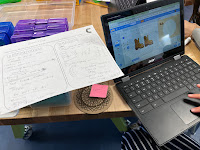Rapid Prototyping as CS Assessment (Design Thinking in CS)
What is design thinking?
Design thinking is an empathy-based, human-centered, problem solving process and mindset. Design thinkers focus on user research, needfinding, and setting aside our own assumptions about the world. It is the mindset in which we design instruction at the TK-8 school in which I work-- Campbell School of Innovation.
Design thinking in CS
As an interviewer, their goal was to seek opportunities for design while talking to their partner. Were there problem spots in the day that they might design around? Or something new that they learned about their partner? Could they design with the intention of making their partner smile?
Design for Partner sprint (two 50-minute class sessions):
- Interview -- 2 minutes to interview your partner and learn as much as you can about their day.
Focus on asking follow-up questions to get more information. - Needfinding -- where do you see opportunity for design? Problem to solve? Design something to make your partner smile?
- Ideate -- 2 minutes to brainstorm (sketch or write) 3 or more technology-based innovation ideas for partner
- Plan -- sketch your prototype with as much detail & pseudocode as you can (5 minutes)
- Rapid Prototype -- choose the best innovation idea for partner, then rapidly prototype using one of the tools/skills we learned in computer science (in this case, Scratch, Python or Circuit Playground Express)
- Share & digital gallery walk -- "present" to your partner by posting your creation with a description in our Seesaw learning portfolios
CS + Design outcomes
From hairstyle/clothing-picker apps to automated pet feeders, bedroom alarm systems to customized video games, and emotional regulation apps, students blew me away with how thoughtful & creative they were in their designs.
Integrating design thinking mindsets into my students' computer science work also allows them to think about how they might apply their skills in the future, and how various computer science skills can be used not only to make fun things, but also to make things that can help others.
Subsequently, many students did find themselves learning new programming & making skills in the process. As they were planning their prototypes, they found inspiration in MakeCode or Scratch tutorials and integrated what they already knew how to do with new ideas and techniques they may not have used before, allowing for a personalized learning experience wrapped into an assessment piece.





Comments
Post a Comment